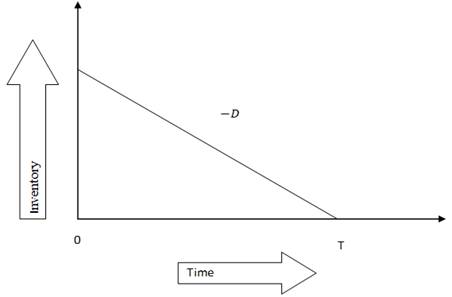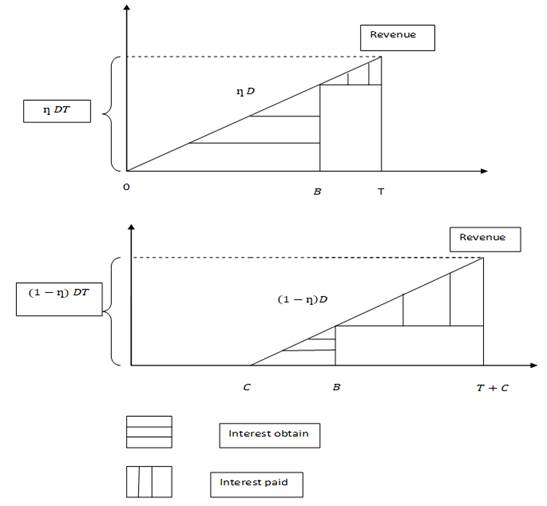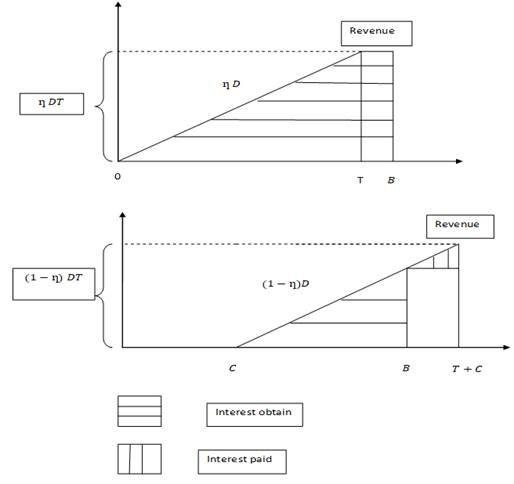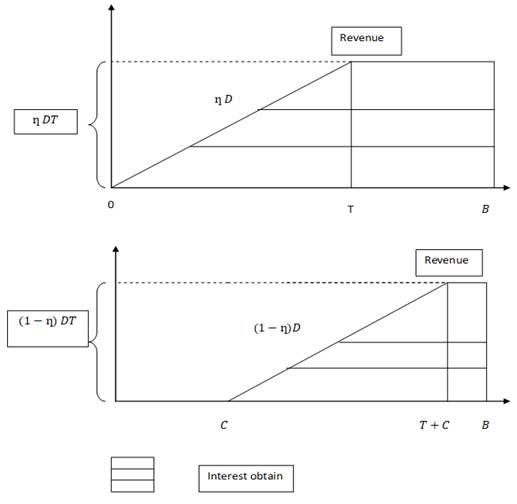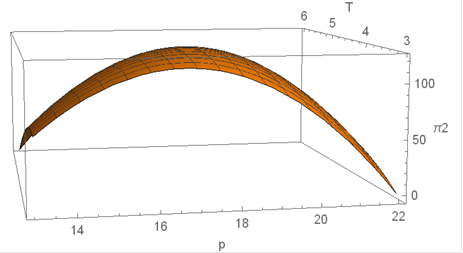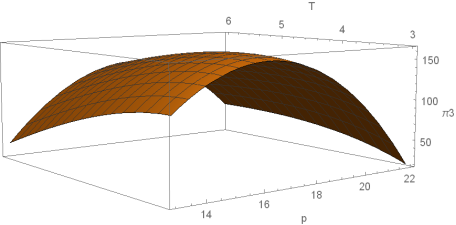|
|
|
|
DETERMINATION OF RETAILER’S OPTIMAL POLICY IN A PRICE-SENSITIVE INVENTORY MODEL FACILIATING TWO TYPES OF PAYMENT SCHEME FOR THE CUSTOMERS1 Department of Mathematics, Chandernagore College, Chandernagore, Hooghly, West Bengal, India |
|
||
|
|
|||
|
Received 20 January 2022 Accepted 25 February 2022 Published 14 March 2022 Corresponding Author Subhankar Adhikari, subhankar_adhikari@yahoo.com DOI 10.29121/ijetmr.v9.i3.2022.1129 Funding: This research
received no specific grant from any funding agency in the public, commercial,
or not-for-profit sectors. Copyright: © 2022 The
Author(s). This is an open access article distributed under the terms of the
Creative Commons Attribution License, which permits unrestricted use, distribution,
and reproduction in any medium, provided the original author and source are
credited.
|
ABSTRACT |
|
|
|
This article investigates the effect of
implementation of two types of payment scheme to the customer by a retailer
in an inventory system. Our study is to determine optimal cycle time and
selling price of a commodity when two types of payment scheme namely
immediate payment scheme as well as trade credit policy are available to the
customer. In reality, two trends of payment scheme
are available in business world. Some people want to pay immediately after
purchase while some favors some time delay in payment. From retailer’s point of view, in many
situations, retailer faces scarcity of capital to start his business. Now- a-
day bank loan is available to the retailer at ease. We formulate a
mathematical model keeping in mind all these things. Two tier credit policies
have been considered. First of all, bank offers a
delay period to repay loan. Secondly, retailer also offers a credit period to
customer. Different cases possible owing to
variable duration of credit periods. Our ultimate
goal is to optimize retailer’s profit for different cases arisen in
the model. A numerical example has been posed and discussed in support of the
model. |
|
||
|
Keywords: Inventory, Price, Bank Loan Facility, Two
Types of Payment Scheme for Customers 1. INTRODUCTION
Mathematical modeling in inventory become very attractive day by day
to the researchers and practitioners as problems associated with inventory
has a close relation with business, economy, and finance. Harris
(1913) was first to introduce inventory in mathematical
modeling. There after many developments has been made. Determination of price
of a commodity is very common problem in inventory. General perception is
that decrease in selling price increases demand rate. Abad
(1996) considered dynamic pricing together with lot-sizing
in an inventory model. In another work Abad
(2001). he assumed selling price dependent demand rate for
items which decays instantaneously. After that many inventory model has been
developed taking demand rate as a monotonic decreasing function of selling
price. It should be noted that demand rate may be linear or non-linear
function of selling price. As limitation of capital is a major challenge in
today’s business world, different types of credit policies have a great
impact in that world. Studies based on the effect of inclusion of trade
credit policy in an inventory system have become much attractive to the
modelers and interpreters This work was started by Goyal
(1985). He was the pioneer to include the effect of |
|
||
introduction of single stage trade credit policy in the inventory system. Huang (2003) extended the concept between supplier and retailer. He assumed that retailer’s offered credit period to the customer is less than the credit period offered by the supplier to the retailer. Jaggi et al. (2008) introduced credit linked demand rate in their model. Chung (2013) implemented the concept of two-level trade credit periods in economic production quantity model with storage capacity constraints. Chung et al. (2014) considered the facility of permissible delay in payment in economic production quantity model for deteriorating items. Giri and Sharma (2016) incorporated the concept of permissible delay in payment in a model where demand rate increases linearly with time. Pal (2018) examined the effect of trade credit policy with partial backlogging of shortages. Giri and Sharma (2019) developed inventory model with partial trade credit policy. Tiwary et al. (2018) introduced two level partial trade credit policy in a three-echelon supply chain associated with perishable items. Mandal et al. (2020) introduces reliability in a production inventory model with two tier credit policy. An inventory model with two stage deterioration under the atmosphere of permissible delay option was formulated by Pal et al. (2021).
2. NOTATIONS
|
Q |
Ordering
quantity of the retailer |
|
W |
Purchasing cost per unit item of the
retailer |
|
P |
Selling price per unit item of the
retailer |
|
S |
Set up cost |
|
D |
Demand rate |
|
|
Holding cost per unit item |
|
|
Cycle length |
|
|
Credit period offered by the bank to the
retailer |
|
|
Credit period offered by retailer to the
customer |
|
|
Obtained interest rate |
|
|
Paid interest rate. |
|
|
A fraction portion of the total customer
make immediate payment on purchase of goods |
|
|
Retailer’s inventory level at time |
3. BASIC ASSUMPTIONS
·
A single item is considered
·
Time horizon is infinite
·
Retailer has some capital to arrange
set-up cost. But he has to go for bank loan for
ordering quantity ![]() .
Banks provide a credit period. After that period bank will charge interest for
remaining unpaid amount. Retailer can enjoy interest from sells revenue up to
the time
.
Banks provide a credit period. After that period bank will charge interest for
remaining unpaid amount. Retailer can enjoy interest from sells revenue up to
the time ![]() .
.
·
Obtained interest rate is less than paid
interest rate.
·
Retailer faces two types of customers. One
category wants to pay immediately after purchase of a thing while another
category wants to avail some time delay for making payment.
·
Retailer offers a credit period ![]() to the customer and sells all items by the
time
to the customer and sells all items by the
time![]() .
From the point of category of customer enjoying permissible delay in payment scheme, if buys item at time
.
From the point of category of customer enjoying permissible delay in payment scheme, if buys item at time ![]() arranges payment at time
arranges payment at time ![]() .
.
·
Retailer’s offered credit period is less
than his cycle length![]()
·
Demand rate ![]() is a monotonic function which decreases
linearly with selling price
is a monotonic function which decreases
linearly with selling price ![]() . Exact form of demand rate is
. Exact form of demand rate is ![]() with
with ![]() .
.
4. MODEL FORMULATION WITH JUSTIFICATION
|
|
|
Figure 1 Retailer’s
time weighted inventory |
Retailer
ordering quantity is ![]() .
This amount depletes at the rate
.
This amount depletes at the rate ![]() .
.
The
differential equation which governs inventory level of the retailer is given
below.
![]() subject to initial condition
subject to initial condition ![]() (1)
(1)
Solution is given by
![]() (2)
(2)
Terminal
condition ![]() gives,
gives,
![]() (3)
(3)
Total
holding cost is given as
![]() =
= ![]() [
using (2) and (3)] (4)
[
using (2) and (3)] (4)
Retailer
goes for bank loan for purchasing amount ![]() . So, bank loan amount is
. So, bank loan amount is
![]() . Two cases come up.
. Two cases come up.
Either
Case1. ![]() or
Case2.
or
Case2. ![]() . Now, Case 2 can be subdivided into
three Sub Cases on the basis of the fact that retailer
collects his final payment from the customer at time
. Now, Case 2 can be subdivided into
three Sub Cases on the basis of the fact that retailer
collects his final payment from the customer at time ![]() . Possible three Sub Cases are given
below.
. Possible three Sub Cases are given
below.
Sub Case2.1 ![]()
Sub Case2.2 ![]()
Sub
Case 2.3 ![]()
Now we will discuss all situations with
figures.
Case 1. ![]()
|
|
|
Figure 2 Immediate
payment scheme (above) and trade credit situation (below) under Case 1 |
For
immediate payment, retailer enjoys the interest from sales revenue for the
period ![]() .
He has to pay interest for the period
.
He has to pay interest for the period ![]() .
.
Interest
obtained = ![]() ,
Interest paid =
,
Interest paid = ![]()
For
permissible delay in payment scheme, retailer does not enjoy any interest from
sales revenue. Interest paid = ![]()
Case
2.1: ![]()
|
|
|
Figure 3 Immediate payment scheme (above) and trade
credit situation (below) under Sub Case 2.1 |
For
immediate payment, Interest obtained = ![]() , Interest
paid =
, Interest
paid = ![]() .
.
For
permissible delay in payment scheme,
Interest
obtained = ![]() ,
,
Interest
paid = ![]()
Case
2.2: ![]()
|
|
|
Figure 4 Immediate
payment scheme (above) and trade credit situation (below) under Sub Case 2.2 |
For
immediate payment, Interest obtained = ![]()
Interest
paid = 0.
For
permissible delay in payment scheme,
Interest
obtained = ![]()
Interest
paid = ![]()
Case
2.3: ![]()
|
|
|
Figure 5 Immediate payment scheme (above) and trade
credit situation (below) under Sub Case 2.3 |
Interest
obtained = ![]()
Interest
paid = 0
For
permissible delay in payment scheme,
Interest
obtained = ![]()
Interest
paid = 0
Retailer’s
average profit = (Selling price – Bank loan- Set up cost- Holding cost +
Interest obtained from sales revenue –Interest paid to the bank) / Cycle
length.
Average
profit function of the retailer for different situations is given in the
following table.
|
Table 1 |
||
|
Case / Sub Case |
Profit function |
Expression |
|
1 |
|
|
|
2.1 |
|
[ |
|
2.2 |
|
[ |
|
2.3 |
|
|
5. SOLUTION METHODOLOGY
We
first solve the following partial differential equations
![]()
Then
we get solutions for cycle length and selling price as ![]() .
These solutions are optimal if the eigen values of the following Hessian matrix
at
.
These solutions are optimal if the eigen values of the following Hessian matrix
at ![]() are negative.
are negative.

6. NUMERICAL EXAMPLE
Values
of parameters for different situations are given below.
Common
parameters to all situations.
|
|
$500 per set up |
|
|
$1.5
per unit |
|
|
$0.07
per annum |
|
|
$0.09
per annum |
|
|
0.3 |
|
|
$6
per unit |
|
|
100 |
|
|
4 |
Parameter
varies along with situations.
|
Case 1 |
Sub Case 2.1 |
Sub Case 2.2 |
Sub Case 2.3 |
|
|
|
|
|
|
|
|
|
|
Optimal
results obtained
|
Case 1 |
Sub Case 2.1 |
Sub Case 2.2 |
Sub Case 2.3 |
|
|
|
$17.56 |
$17.11 |
$16.58 |
$15.99 |
|
|
4.01 |
3.86 |
3.54 |
3.25 |
|
Average
profit |
$99.07 |
$124.10 |
$163.01 |
$238.36 |
Conditions of
optimality
|
Eigen
values of the hessian matrix |
Case 1 |
Sub Case 2.1 |
Sub Case 2.2 |
Sub Case 2.3 |
|
|
|
|
|
Now we show three-dimensional plotting of retailer’s
average profit function with respect to two decision variables selling price
and cycle length for Case1, Sub Case 2.1, Sub Case 2.2, Sub Case 2.3 respectively.
|
|
|
Figure 6 Profit function for Case 1 with respect to
decision variables selling price (p) and cycle length (T) |
|
|
|
Figure 7 Profit function for Sub Case 2.1 with
respect to decision variables |
|
|
|
Figure 8 Profit function for Sub Case 2.2 with
respect to decision variables |
|
|
|
Figure 9 Profit function for Sub Case 2.3 with
respect to decision variables |
All these diagrams ensure maximization of retailer’s
profit function. This section has been performed with the help of MATHEMATICA
SOFTWARE.
7. CONCLUSION
In this work we have presented a mathematical model which maximizes retailer average profit depending on decision variables namely cycle time and selling price. Different situations associated with two stage trade credit have been considered. It has been observed from numerical results that retailer profit increases as length of the credit period offered by the bank increases. Here we take demand pattern based on selling price linearly. This work may be extended by taking non-linear demand pattern. Also credit linked as well as selling price dependent demand pattern may be a possible extension of this modelling frame work.
REFERENCES
Abad, P.L. (1996), Optimal pricing and lot-sizing under conditions of perishability and partial backordering, Management Science, 42(8) :1093-1104. Retrieved from https://doi.org/10.1287/mnsc.42.8.1093
Abad, P.L. (2001), Optimal price and order size for a reseller under partial backordering, Computers and Operations Research, 28, 53-65. Retrieved from https://doi.org/10.1016/S0305-0548(99)00086-6
Chung, K-J, (2013), The EPQ model under conditions of two levels trade credit and limited storage capacity in supply chain management, International Journal of System Science,44(9),1675-1691. Retrieved from https://doi.org/10.1080/00207721.2012.669864
Chung, K-J, Cardenas-Barron, L.E., Ting, P-S., (2014), An inventory model withnon-instantaneous receipt and exponentially deteriorating item for an integrated three layer supply chain under two levels of trade credit, International Journal of Production Economics,155,310-317. Retrieved from https://doi.org/10.1016/j.ijpe.2013.12.033
Giri, B.C., Sharma, S., (2016), Optimal ordering policy for an inventory system with linearly increasing demand and allowable shortages under two levels of trade credit financing, Operational Research, 16(1),25-50. Retrieved from https://doi.org/10.1007/s12351-015-0184-y
Giri, B.C., Sharma, S., (2019), Optimising an integrated production-inventory system under cash discount and retailer partial trade credit policy. Journal of System Science : Operations and Logistics,6(2), 99-118. Retrieved from https://doi.org/10.1080/23302674.2017.1371358
Goyal, S.K. (1985), Economic order quantity under conditions of permissible delay in payments, Journal of Operational Research Society,36(4),335-338. Retrieved from https://doi.org/10.1057/jors.1985.56
Harris, F.W. (1913), How many parts to make at once, Factory, The Magazine of Management,10(2) ,135-136.
Huang,Y-F.(2003),Optimal retailer's ordering policies in the EOQ model under trade credit financing, Journal of Operational Research Society,54,1011-1015. Retrieved from https://doi.org/10.1057/palgrave.jors.2601588
Jaggi,C.K., Goyal, S.K, Goel, S.K.,(2008), Retailer's optimal replenishment decisions with credit-linked demand under permissible delay in payments, European Journal of Operational Research, 190,130-135. Retrieved from https://doi.org/10.1016/j.ejor.2007.05.042
Mandal, A., Pal, B., Chaudhuri, K.S. (2020), Unrelaible EPQ model with variable demand under two-tier credit financing, Journal of Industrial and Production Engineering,37(7),370-386. Retrieved from https://doi.org/10.1080/21681015.2020.1815877
Pal, B. (2018), Optimal production model with quality sensitive market demand, partial backlogging and permissible delay in payment, RAIRO-Operations Research, 52, 499-512. Retrieved from https://doi.org/10.1051/ro/2017068
Pal, B., Mandal, A., Sana, S.S. (2021), Two-phase deteriorated supply chain model with variable demand and imperfect production process under two-stage credit financing. RAIRO-Operations Research, 55, 457-580. Retrieved from https://doi.org/10.1051/ro/2021008
Tiwary, S., Cardenas-Barron, L.E., Goh, M., Shaikh, A. A., (2018), Joint pricing and inventory model for deteriorating items with expiration dates and partial backlogging under two-level partial trade credits supply chain, International Journal of Production Economics,200,16-36. Retrieved from https://doi.org/10.1016/j.ijpe.2018.03.006
|
|
 This work is licensed under a: Creative Commons Attribution 4.0 International License
This work is licensed under a: Creative Commons Attribution 4.0 International License
© IJETMR 2014-2022. All Rights Reserved.



